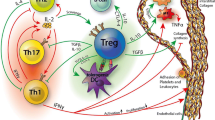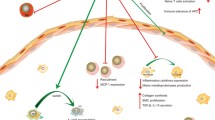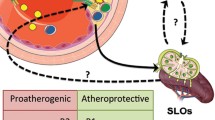Abstract
Although the pathogenic role of T cells in atherogenesis is well established, the function of the various T-cell subsets is far from clear. Whereas activation of the T-helper type 1 (Th1) subset promotes inflammatory and proatherogenic responses and activation of Th2 cells mediates both proatherogenic and antiatherogenic effects, the newly discovered regulatory T-cell subset seems to attenuate atherogenesis. However, the dynamics of T-cell response within the plaque are still poorly understood, and both antigen-dependent and antigen-independent stimuli may be involved in the expansion of T cells in atherosclerotic plaques. Nevertheless, the different nature of the various T-cell subsets and their complex role in atherogenesis underscore the need for future research in this field of atheroimmunology. This research is not only of interest for the basic research field, but may also have relevance for clinical cardiology, potentially leading to new targets for therapy in atherosclerotic disorders.
Similar content being viewed by others
References and Recommended Reading
Glass CK, Witztum JL: Atherosclerosis. The road ahead. Cell 2001, 104:503–516.
Hansson GK: Inflammation, atherosclerosis, and coronary artery disease. New Engl J Med 2005, 352:1685–1695.
Robertson AK, Hansson GK: T cells in atherogenesis: for better or for worse? ArteriosclerThromb Vasc Biol 2006, 26:2421–2432.
Zhou X, Nicoletti A, Elhage R, Hansson GK: Transfer of CD4(+) T cells aggravates atherosclerosis in immunodeficient apolipoprotein E knockout mice. Circulation 2000, 102:2919–2922.
Daugherty A, Rateri DL: T lymphocytes in atherosclerosis: the yin-yang of Th1 and Th2 influence on lesion formation. Circ Res 2002, 90:1039–1040.
Harvey EJ, Ramji DP: Interferon-gamma and atherosclerosis: pro-or anti-atherogenic? Cardiovasc Res 2005, 67:11–20.
Liuzzo G, Kopecky SL, Frye RL, et al.: Perturbation of the T-cell repertoire in patients with unstable angina. Circulation 1999, 100:2135–2139.
Ranjbaran H, Sokol SI, Gallo A, et al.: An inflammatory pathway of IFN-gamma production in coronary atherosclerosis. J Immunol 2007, 178:592–604.
Koga M, Kai H, Yasukawa H, et al.: Inhibition of progression and stabilization of plaques by postnatal interferon-gamma function blocking in ApoE-knockout mice. Circ Res 2007, 101:348–356.
Gupta S, Pablo AM, Jiang X, et al.: IFN-gamma potentiates atherosclerosis in ApoE knock-out mice. J Clin Invest 1997, 99:2752–2761.
Whitman SC, Ravisankar P, Daugherty A: Interleukin-18 enhances atherosclerosis in apolipoprotein E(-/-) mice through release of interferon-gamma. Circ Res 2002, 90:E34–E38.
Liuzzo G, Vallejo AN, Kopecky SL, et al.: Molecular fingerprint of interferon-gamma signaling in unstable angina. Circulation 2001, 103:1509–1514.
Libby P, Sukhova G, Lee RT, Galis ZS: Cytokines regulate vascular functions related to stability of the atherosclerotic plaque. J Cardiovasc Pharmacol 1995, 25(Suppl 2):S9–S12.
Niwa T, Wada H, Ohashi H, et al.: Interferon-gamma produced by bone marrow-derived cells attenuates atherosclerotic lesion formation in LDLR-deficient mice. J Atheroscler Thromb 2004, 11:79–87.
Getz GS: Thematic review series: the immune system and atherogenesis. Immune function in atherogenesis. J Lipid Res 2005, 46:1–10.
Binder CJ, Hartvigsen K, Chang MK, et al.: IL-5 links adaptive and natural immunity specific for epitopes of oxidized LDL and protects from atherosclerosis. J Clin Invest 2004, 114:427–437.
Caligiuri G, Nicoletti A, Poirier B, Hansson GK: Protective immunity against atherosclerosis carried by B cells of hypercholesterolemic mice. J Clin Invest 2002, 109:745–753.
Freigang S, Horkko S, Miller E, et al.: Immunization of LDL receptor-deficient mice with homologous malondialdehyde-modified and native LDL reduces progression of atherosclerosis by mechanisms other than induction of high titers of antibodies to oxidative neoepitopes. Arterioscler Thromb Vasc Biol 1998, 18:1972–1982.
Shimizu K, Shichiri M, Libby P, et al.: Th2-predominant inflammation and blockade of IFN-gamma signaling induce aneurysms in allografted aortas. J Clin Invest 2004, 114:300–308.
Shimizu K, Libby P, Mitchell RN: Local cytokine environments drive aneurysm formation in allografted aortas. Trends Cardiovasc Med 2005, 15:142–148.
Davenport P, Tipping PG: The role of interleukin-4 and interleukin-12 in the progression of atherosclerosis in apolipoprotein E-deficient mice. Am J Pathol 2003, 163:1117–1125.
Stockinger B, Veldhoen M, Martin B: Th17 T cells: Linking innate and adaptive immunity. Semin Immunol 2007, 19:353–361.
Bettelli E, Oukka M, Kuchroo VK: T(H)-17 cells in the circle of immunity and autoimmunity. Nat Immunol 2007, 8:345–350.
Patel DN, King CA, Bailey SR, et al.: Interleukin-17 stimulates C-reactive protein expression in hepatocytes and smooth muscle cells via p38 MAPK and ERK1/2-dependent NF-kappaB and C/EBPbeta activation. J Biol Chem 2007, 282:27229–27238.
Venugopal SK, Devaraj S, Jialal I: Effect of C-reactive protein on vascular cells: evidence for a proinflammatory, proatherogenic role. Curr Opin Nephrol Hypertens 2005, 14:33–37.
Hashmi S, Zeng QT: Role of interleukin-17 and interleukin-17-induced cytokines interleukin-6 and interleukin-8 in unstable coronary artery disease. Coron Artery Dis 2006, 17:699–706.
Halvorsen B, Waehre T, Scholz H, et al.: Interleukin-10 enhances the oxidized LDL-induced foam cell formation of macrophages by antiapoptotic mechanisms. J Lipid Res 2005, 46:211–219.
Waehre T, Halvorsen B, Damas JK, et al.: Inflammatory imbalance between IL-10 and TNFalpha in unstable angina potential plaque stabilizing effects of IL-10. Eur J Clin Invest 2002, 32:803–810.
Tedgui A, Mallat Z: Interleukin-10: an anti-atherogenic cytokine? Eur J Clin Invest 2001, 31:1–2.
Grainger DJ: TGF-beta and atherosclerosis in man. Cardiovasc Res 2007, 74:213–222.
Robertson AK, Rudling M, Zhou X, et al.: Disruption of TGF-beta signaling in T cells accelerates atherosclerosis. J Clin Invest 2003, 112:1342–1350.
Mor A, Planer D, Luboshits G, et al.: Role of naturally occurring CD4+ CD25+ regulatory T cells in experimental atherosclerosis. Arterioscler Thromb Vasc Biol 2007, 27:893–900.
Ait-Oufella H, Salomon BL, Potteaux S, et al.: Natural regulatory T cells control the development of atherosclerosis in mice. Nat Med 2006, 12:178–180.
de Boer OJ, van der Meer JJ, Telling P, et al.: Low numbers of FOXP3 positive regulatory T cells are present in all developmental stages of human atherosclerotic lesions. PLoS ONE 2007, 2:e779.
Heller EA, Liu E, Tager AM, et al.: Chemokine CXCL10 promotes atherogenesis by modulating the local balance of effector and regulatory T cells. Circulation 2006, 113:2301–2312.
Wilczynski JR, Radwan M, Kalinka J: The characterization and role of regulatory T cells in immune reactions. Front Biosci 2008, 13:2266–2274.
Mausner-Fainberg K, Luboshits G, Mor A, et al.: The effect of HMG-CoA reductase inhibitors on naturally occurring CD4(+)CD25(+) T cells. Atherosclerosis 2007 [Epub ahead of print].
Oukka M: Interplay between pathogenic Th17 and regulatory T cells. Ann Rheum Dis 2007, 66(Suppl 3):iii87–iii90.
Mangan PR, Harrington LE, O’Qinn DB, et al.: Transforming growth factor-beta induces development of the T(H)17 lineage. Nature 2006, 441:231–234.
Ludewig B, Freigang S, Jaggi M, et al.: Linking immune-mediated arterial inflammation and cholesterol-induced atherosclerosis in a transgenic mouse model. Proc Natal Acad Sci U S A 2000, 97:12752–12757.
Skjelland M, Michelsen AE, Krohg-Sorensen K, et al.: Plasma levels of granzyme B are increased in patients with lipid-rich carotid plaques as determined by echogenicity. Atherosclerosis 2007, 195:e142–e146.
Gotsman I, Grabie N, Dacosta R, et al.: Proatherogenic immune responses are regulated by the PD-1/PD-L pathway in mice. J Clin Invest 2007, 117:2974–2982.
Olofsson PS, Söderström LÅ, Wagsater D, et al.: CD137 is expressed in human atherosclerosis and promotes development of plaque inflammation in hypercholesterolemic mice. Circulation 2008, In press.
Wick G, Knoflach M, Xu Q: Autoimmune and inflammatory mechanisms in atherosclerosis. Ann Rev Immunol 2004, 22:361–403.
Damås JK, Waehre T, Yndestad A, et al.: Interleukin-7-mediated inflammation in unstable angina: possible role of chemokines and platelets. Circulation 2003, 107:2670–2676.
Houtkamp MA, van Der Wal AC, de Boer OJ, et al.: Interleukin-15 expression in atherosclerotic plaques: an alternative pathway for T-cell activation in atherosclerosis? Arterioscler Thromb Vasc Biol 2001, 21:1208–1213.
Buono C, Pang H, Uchida Y, et al.: B7-1/B7-2 costimulation regulates plaque antigen-specific T-cell responses and atherogenesis in low-density lipoprotein receptor-deficient mice. Circulation 2004, 109:2009–2015.
van Puijvelde GH, Hauer AD, de Vos P, et al.: Induction of oral tolerance to oxidized low-density lipoprotein ameliorates atherosclerosis. Circulation 2006, 114:1968–1976.
Gotsman I, Grabie N, Gupta R, et al.: Impaired regulatory T-cell response and enhanced atherosclerosis in the absence of inducible costimulatory molecule. Circulation 2006, 114:2047–2055.
Sakaguchi S, Sakaguchi N, Asano M, et al.: Immunologic self-tolerance maintained by activated T cells expressing IL-2 receptor alpha-chains (CD25). Breakdown of a single mechanism of self-tolerance causes various autoimmune diseases. J Immunol 1995, 155:1151–1164.
Liuzzo G, Goronzy JJ, Yang H, et al.: Monoclonal T-cell proliferation and plaque instability in acute coronary syndromes. Circulation 2000, 101:2883–2888.
Zhang X, Niessner A, Nakajima T, et al.: Interleukin 12 induces T-cell recruitment into the atherosclerotic plaque. Circ Res 2006, 98:524–531.
Smook ML, Heeringa P, Damoiseaux JG, et al.: Leukocyte CD40L deficiency affects the CD25(+) CD4 T cell population but does not affect atherosclerosis. Atherosclerosis 2005, 183:275–282.
Lee WH, Kim SH, Lee Y, et al.: Tumor necrosis factor receptor superfamily 14 is involved in atherogenesis by inducing proinflammatory cytokines and matrix metalloproteinases. Arterioscler Thromb Vasc Biol 2001, 21:2004–2010.
Otterdal K, Andreassen AK, Yndestad A, et al.: Raised LIGHT levels in pulmonary arterial hypertension—potential role in thrombus formation. Am J Respir Crit Care Med 2008, 177:202–207.
Otterdal K, Smith C, Oie E, et al.: Platelet-derived LIGHT induces inflammatory responses in endothelial cells and monocytes. Blood 2006, 108:928–935.
Scholz H, Sandberg W, Damås JK, et al.: Enhanced plasma levels of LIGHT in unstable angina: possible pathogenic role in foam cell formation and thrombosis. Circulation 2005, 112:2121–2129.
van Wanrooij EJ, van Puijvelde GH, de Vos P, et al.: Interruption of the Tnfrsf4/Tnfsf4 (OX40/OX40L) pathway attenuates atherogenesis in low-density lipoprotein receptor-deficient mice. Arterioscler Thromb Vasc Biol 2007, 27:204–210.
Damås JK, Boullier A, Waehre T, et al.: Expression of fractalkine (CX3CL1) and its receptor, CX3CR1, is elevated in coronary artery disease and is reduced during statin therapy. Arterioscler Thromb Vasc Biol 2005, 25:2567–2572.
Schneider MA, Meingassner JG, Lipp M, et al.: CCR7 is required for the in vivo function of CD4+ CD25+ regulatory T cells. J Exp Med 2007, 204:735–745.
Author information
Authors and Affiliations
Corresponding author
Rights and permissions
About this article
Cite this article
Aukrust, P., Otterdal, K., Yndestad, A. et al. The complex role of T-cell-based immunity in atherosclerosis. Curr Atheroscler Rep 10, 236–243 (2008). https://doi.org/10.1007/s11883-008-0037-8
Published:
Issue Date:
DOI: https://doi.org/10.1007/s11883-008-0037-8




